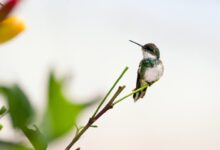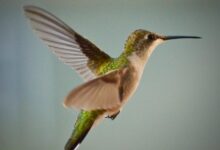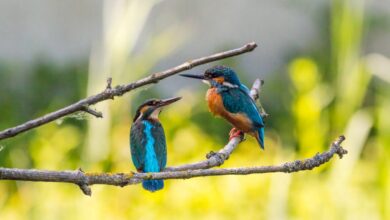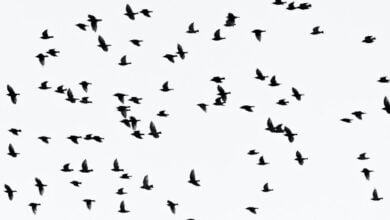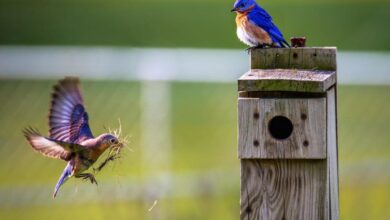
Attracting Birds to a Tropical Garden
Some individuals enjoy bird watching but prefer to do their bird watching in their back yard. Below is some advice on attracting wild birds to your back yard.
Firstly it depends upon having wild birds in the general area where your house is located and then you can attract then to your backyard.
The method used to attract the birds will depend upon what is the diet of the bird. If the bird is a nectar feeder e.g. bananaquits or hummingbirds, then large flowering plants will attract them.
Hummingbird bills are perfectly adapted to the various types of flowers that they feed on, so different types of flowers will attract different hummingbirds.
Some hummingbirds have especially curved or elongated bills that allow them to feed on special flowers, eg the White-tipped Sicklebill hummingbird whose downward curving bill allows it to draw nectar from heliconias.
The Ruby-Topaz Hummingbird has a short and slightly decurved bill that is suited to feeding on the flowers of the ixora shrub.
The Blue-tailed Emerald has a short bill that is suited for feeding on the Hibiscus flower. The Copper-rumped Hummingbird has a straight long bill that allows it to feed on medium sized tube shaped flowers such as the allamanda.
Hummingbirds have little or no sense of smell, so colour is important to a hummingbird’s search process for locating flowers containing nectar.
While they will visit any flower that has sufficient nectar they prefer flowers that are red to orange in colour. It is believed that this colour preference is due to the fact that red flowers standout in a green background and so are more easily seen by the hummingbird.
It is also believed that because hummingbirds compete with insects for nectar they choose flowers that are less likely to be visited by insects.
Most insects do not see well at the red end of the colour spectrum and so may not visit red flowers while hummingbirds see the full visible spectrum.
If space in your yard is very limited, preventing you from having large flowering shrubs, an area to consider is the curb area between your property line and the roadway. You can plant small flowering shrubs such as the miniature ixora, which will then attract nectar feeding birds to your property.
For birds that are fruit eaters, the presence of ripe fruit will attract and so having fruit trees will attract birds. The majority of trees however only fruit once per year for a few months, so the attraction is not year round.
If your garden has sufficient space then multiple fruit trees that bear at different times in the year will ensure a continuous bird presence. One tree that bears fruit for a very extended period is guava and so can attract birds for most of the year.
Trees are also an attraction to birds because they provide nesting and resting sites. If you have the palm trees that people usually plant in from their houses that will generally attract Palm Tanagers who will feed on the small nuts, use material from the tree for building their nests and may also nest in the tree.
When a large number of flowering shrubs and/or fruit trees is not an option, you can consider purchasing a bird feeder. The type of feeder will also be dependent upon the type of birds in the area and the type of birds that you want to attract.
For nectar feeders you use a sugar solution (the feeder usually has directions). You must put the feeder in a location where the birds will see it and you must change the solution regularly (2 -3 days).
Red Feeders are good for attracting hummingbirds because they have a preference for red flowers. If you use a feeder it will take a few days for the birds to recognise that it is present in your yard.
Other feed can attract other types of birds. Bare-Eyed Thrushes and Kiskadees are somewhat omnivorous and so you can use rice (not boiled). I have found that they will also be attracted by dog food.
Tropical Mockingbirds can also be attracted with rice. In addition, ripe fruit such bananas, mangoes and cherry can be used and will usually attract Blue-Gray Tanagers, Palm Tanagers and Yellow Orioles.
As an alternative to purchasing a feeder you can construct a feeder. For fruits you can build a simple chicken wire basket or bamboo joint to hold the fruit and attach it to the fence.
Another low cost feeder can be constructed using a plastic bowl with a narrow edge. To construct this feeder you punch three holes, equidistant around the bowl.
Then attach wire strands through each hole with the strands coming together at the top to form either a hook or a loop for suspending the bowl.
Three strands are required to provide stability to the bowl particularly when birds alight on the bowl to feed. It is necessary to punch several holes in the base of the bowl to allow any rainwater or liquids to drain out the bowl.
Attracting birds, apart from the visual delight also provides the benefit of controlling the insect population, as many birds are insect feeders.
Hummingbird Feeders: Sheltering Nature’s Lovely Creatures
Even before manufacturers took advantage of the growing popularity of feeding hummingbirds, the first hummingbird feeders were typically constructed out of laboratory apparatuses.

These were constructed primarily to attract the birds that would normally fly around a garden. To these, the response of the manufacturers is to market and create sugar-water feeders.
Many of which are uniquely created thus giving logic to the high cost of each feeder. But most are mass-produced to provide such equipments to the larger public.
Like with most things in the market, hummingbird feeders come in literally all forms of shapes, sizes and designs. The ideal feeders are those that can be cleaned easily and hangs readily.
These must also be sturdy and must have limited number of parts that can be separated or broken. Majority of hummingbird feeders comes with both glass and plastic reservoirs.
Glasses have longer lifespan and may be cleansed easily but may shatter when dropped. Plastics on the other hand are relatively cheaper than that of the glass reservoirs but discoloration is notable.
Small feeders typically have only a port for feeding while larger feeders have three or more. Many of which may provide perches for hummingbirds to rest upon while feeding.
The most common mistake among novice feeders is the buying of overly sized hummingbird feeders. This is wrong since the water-sugar solution easily stales even before the arrival of the birds.
One hummingbird feeder may not be enough for the birds in a moderately sized garden. It is best to place two or if possible, several hummingbird feeders throughout the garden.
Chances are, the dominant birds would not defend all locations. This may welcome larger number of birds in your place.
Logically, it is a good idea to put these hummingbird feeders in locations where you may observe the birds feeding. After all, the sugar solution we give is just a bonus the birds get for dropping by in our places. They, at all rate, can survive even without our help.
Most hummingbirds are gone during winter. This is because they migrate to the tropical regions. If in any case a bird visits you during this season, it is likely that it is genetically inferior and cannot travel.
To provide shelter for such birds, some enthusiasts prefer to leave the hummingbird feeders outside their homes, offering both food and sanctuary for the lovely creatures. The sugar-water solution in the hummingbird feeder must still be changed daily.
When choosing a hummingbird feeder, most experts recommend those that are red in color. Though there so little scientific research to support the claim that hummingbirds are especially attracted to red, most feeders seem to appear in shades of red.
Plus the common practice of dying the water sugar solution with red. Choose a hummingbird feeder that has excellent protection over ants.
It is also good to restrain from buying a yellow-colored feeders. This is to avoid the bees and wasps from being attracted to the feeder. Look also for feeders that have built-in perches and those that are small.
Only when you have determined how thick your visitation of these birds is, may you only start using bigger feeders. This principle will prevent the nectar solution from spoilage.
Hummingbirds are truly marvelous to look at especially with their aerial display. This probably is reason enough why most enthusiasts go crazy over feeding hummingbirds.
What do birds like eating?
What do birds like eating? Here we came to my favorite topic : I am a great glutton that is why I try to please my birds .
The main parrot food is millet. It is sold in every ”bird” shop . There should always be enough millet into the bird cage , birds know themselves how much to eat . They also enjoy oats very much but only oats ( unpeeled , absolutely natural ) which I haven’t seen anywhere in shops : – ((. It is found only as an addition in combined foods . As a compromise variant oat kernels can be given .
They also enjoy sunflower seeds , but not baked of course Give sunflower seeds to your bird only several times per month because it contains lots of fats and the bird gets stout. Before giving it to the bird it is good to crash it slightly (thus they will consume it easily) .
They absolutely adore fresh vegetables! They die for cucumbers , lettuce, carrots, peppers and pepper seeds ( they should not be hot !). They also eat cabbage . Be careful with nitrates ! They are particularly harmful for birds as they can even kill them If it is possible prevent buying foods cultivated in green – houses.
Other ” green food ” that they like very much is ordinary fresh and tender grass . I mean ryegrass , clover especially couch – grass or something likes , but not that grass ! Something that you should never give them is parsley ! I don ‘ t know why , but it is written so in the books and I have ‘ n ‘ t made experiments what will happen to them if I feed birds with parsley .
Give them fresh fruit at any possibility apples (They like cores because of the seeds ), pears , plums and also pumpkin. I haven’t noticed them to like citrus fruit .
All fruit and vegetables should be well washed .
Give them hard – boiled egg ( a quarter of egg per two birds ) at least once a month. From it they supply themselves with proteins and vitamin D.
Don’t throw the shell away ! Give it to them finely crushed . It provides them with calcium .
Another resource of calcium is chalk . Birds gnaw it with appetite so be sure always to provide chalk in the cage .
Birds like eating bread. It doesn’t matter what kind it is . Put a piece of slightly damped bread between the bars and they will tackle it so that your appetite will come back to you.
There should always be sand in the bird cage ( that is why I told you in the beginning that you should buy two vessels for food ). They need the sand in order to assimilate food easier. Food does not go to the bird’s stomach directly. Before that it stays for some time into its throat. There due to enzymes and the sand all grain foods taken get broken to pieces, get soft and get digested preliminary . The sand should be fine , that is why you must sift it well and to remove the coarse fractions , because they can block the bird ‘ s throat . It is compulsory to wash the sand , to boil it for a sort time in hot water, to dry it and only then to give it to the birds . Sea – sand is very appropriate , but it must be well – washed from salt !!! Salt is not very useful for birds .
Toxic Household Items for Birds
If you have a pet of any kind, safety should always be your number one priority. There are so many things that humans use in their daily lives that are toxic to the animals we protect. No matter what kind of animal you have as a pet, you have to be sure that you are never allowing them to be harmed in any way by something that they might find on the floor or in your home. With birds, this is especially important.
For most birds, who spend a lot of their time, if not all of their time, in a cage, most of the items you have in your home won’t be able to hurt them. However, if your bird is allowed to fly around your house (and remember that it is good for all pet birds to spend some time each day outside of their cages) you have to be sure that your home is bird proof. All of your household chemicals and things that they might eat should be put away and put into cupboards that are shut where the bird can’t get. Remember, with birds, high shelves aren’t the option, unless your bird has its wings clipped and cannot fly. If your bird is allowed out in your house, you have to be sure that there is nothing that they could get.
On the other hand, you might think if your bird is always in its cage, you have nothing to worry about. This is true of anything toxic that might be laying around your house, such as bottles of cleaners or other things that an animal could get into, but that your bird can’t because it is in a cage. However, you would be wrong to assume that just because your bird can’t get out of their cage, they are safe.
Air fresheners, carpet sprays, and any other cleaner that can get into the air is going to be possibly toxic to a bird. You should never spray any of these near your birds cage, and you should take care so that the fumes from any of these cleaners don’t drift into the cage.
You have to be sure that you remember that a bird is very small, and that it will only take a very small amount to kill a bird. No matter what it is, keep it away from your birds, and your birds will stay safe and healthy. When in doubt, talk to your vet.
Why do birds scream
Boy if we had THE answer we’d be writing this from our yacht. But of course I have to weigh in here. What got me thinking about the subject of “why birds scream,” is some recent web surfing.
I spend my days doing what many of you wish you could be doing, surfing the web for bird toys and parrot cages. The magic of the internet enables us to shop the world. In order for us to provide the best possible shopping experience. We look at lots of sites and products. Pricing is important but not our priority. We feel good information about parrots and general avian issues is the most important product we can offer. And we offer that for free. We like to know who’s selling what. We also like to see how well they’re selling it i.e. is the site easy to navigate. Do they offer multiple payment choices and so forth?
But I digress – So here I am on the of a national chains of pet supply products. They have an FAQ for bird ownership. Something we always applaud. Well I’m reading the list and one of the topics is Why is my bird screaming? No real explanation is offered and at the end of the paragraph they recommend taking your parrot to a vet if screaming persists.
Yikers! Screaming parrots – vets – why?
Let’s look at this logically folks, not that parrots are logical but they are creatures of habit. One of the things we learned from Michelle Karras www.thepoliteparrot.com is silence means danger! If you have a flock of wild parrots in trees (in their natural environment) or even a flock of local wild birds in your back yard. On any given sunny day a flock of birds will make a lot of noise – it’s all about FLOCK. Chirp, chirp, scream, scream. What are they communicating about? Same things we do. “Find any food lately? Yeah they had a great sale on worms about a mile from here.”
SILENCE means danger! If you’ve ever seen a hawk fly over a flock of wild birds, you swear you can hear the sound of the hawk’s wings flapping. That’s one of the reasons parrots come in so many colors. If they’re quiet and deep in a tree they are difficult to spot. When that danger passes its chirp, chirp, scream, scream. So again I ask, “is screaming a reason to run to the vet? I don’t think so.
Something we hear a lot of is – people will have a screaming bird (usually newbie’s) and the bird will scream for whatever reason. What does their human companion do? Yell SHUT UP! And what does the parrot do? SCREAM SOME MORE!
Again I fall back on my good friend logic. The bird screams, you scream back. Do you think there may be a slight chance that when you scream back the bird might be thinking “hey – this is great! Someone is finally squawking back at me “hey SCREAM, SCREAM, please scream back some more, I’m lonely you’re my flock and I need to talk to someone than you?”
Begin to see where I’m going with this grasshopper? OK so now you know one of the whys. Here’s a little tip form Michelle Karras www.thepoliteparrot.com that may work for you:
Excessive screaming is a learned behavior that we teach our birds. Covering your feathered companion with a blanket, teaches him or her that you will cover the cage when scream gets out of hand.
Yelling at a screaming parrot, gives the parrot the attention it seeks. Ignoring a screaming parrot is not the answer either. Ignoring bird’s screams could result in finding injuries too late (or water had run out).
Options are to make sure all your Psittacines needs are satisfied. Large hygienic cage, clean water, fresh food, working toys. Twelve hours of sleep (uninterrupted), soft wood and other materials to chew, and plenty of exercise.
Start with a signal to stop loud parrots. Ring a cowbell (or bang a pot) in the room next to the screaming bird. They hear the bell (sound), they stop to listen, Show up from the other room while they are quiet to praise and reward.
Set them up to succeed. Use a time when you know they are quite loud. Distract them with a new noise in the next room. As soon as they stop to listen, appear and praise.
Lengthen the time between the signal and your appearance each time. Try and take a whole day at first and only work with the parrot and the screaming.
Initial rewards should be substantial, a known favorite treat. Use the same signal just before feeding fresh food. Wait until the parrot is noisy; give the signal, praise, and feed.
Not all parrots will quiet down for the same signal so you may have to try several noises before finding the one that works for you.
Note: Do not use your voice. They may try to mimic you.
Scream time is a time during the day that you allow your parrots to be noisy. This should be given somewhere between 3p.m. and 7p.m. each day.
Encourage your parrots by playing stimulating music. Dance, sing or scream along with them. Scream time should last no less than 15minutes and no more than 1/2 hour each day.
Some parrots enjoy screaming to the vacuum, this is fine to encourage but play music as well. Find music that your parrot gets excited over. Use that same song every day for scream time.
Change the music from time to time but be consistent overall. When Scream time is over, lower the music volume Talk your parrot down.
Lower the music slowly, turn it off, and play their relaxation code music. Give them afternoon snacks when “cool down” is over.
Birds will wait for their “Scream Time” because they know they will be rewarded for their patience.
how to attract birds,how to attract birds to feeder,how to attract birds to your garden,how to attract birds to your hand,garden bird eggs,plants that attract birds,attracting birds spiritual meaning,how to attract birds without a feeder,
